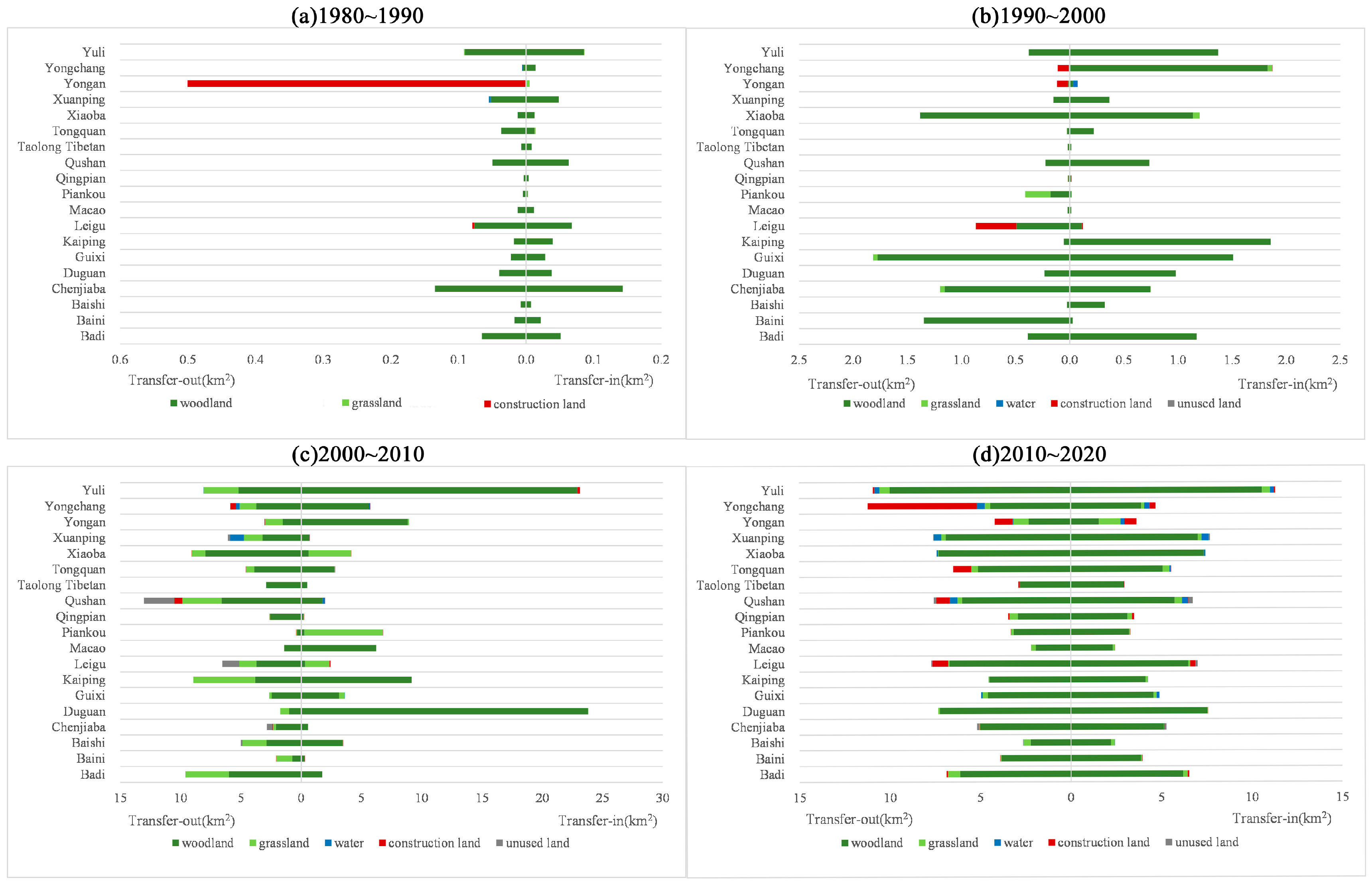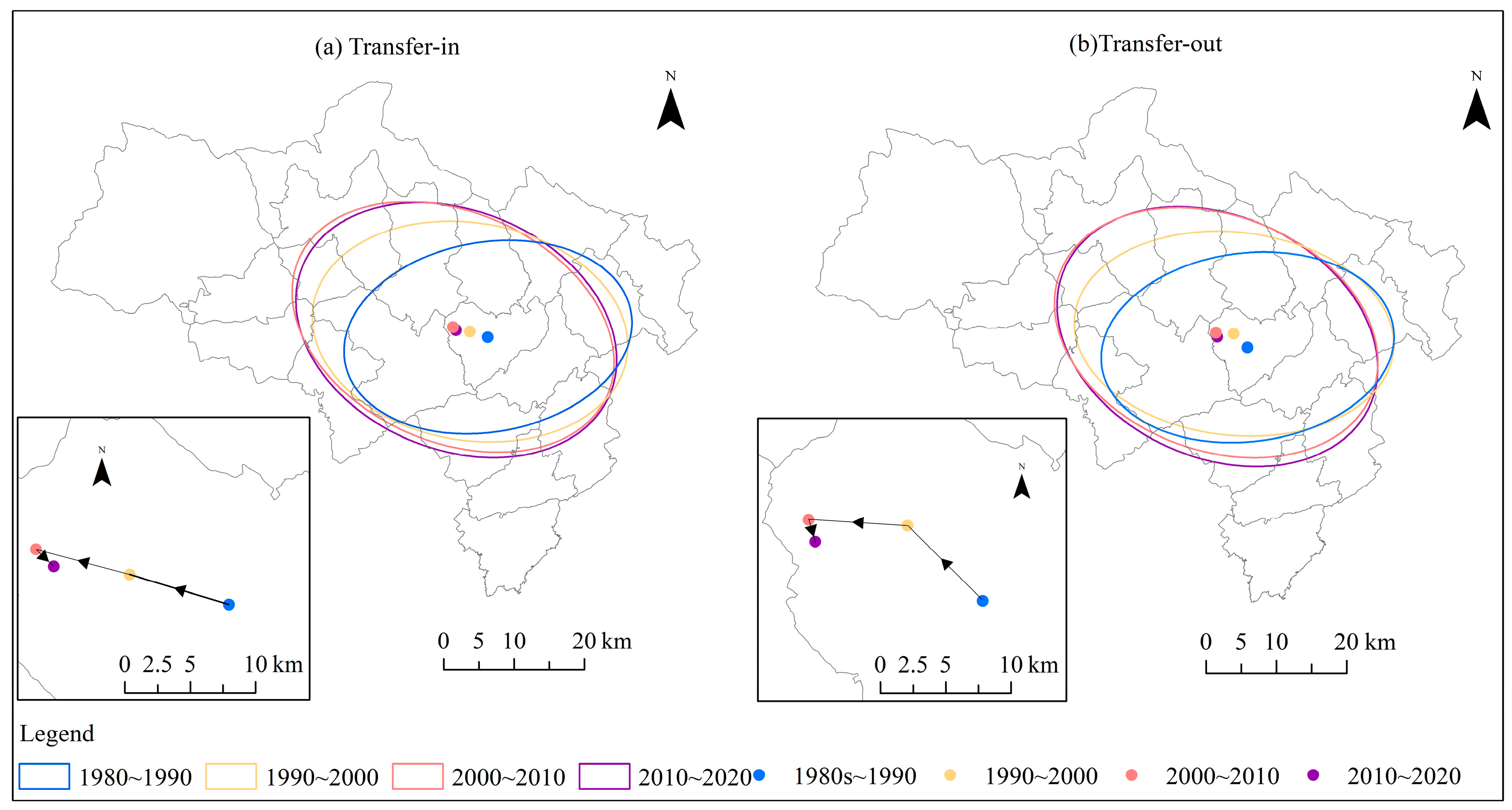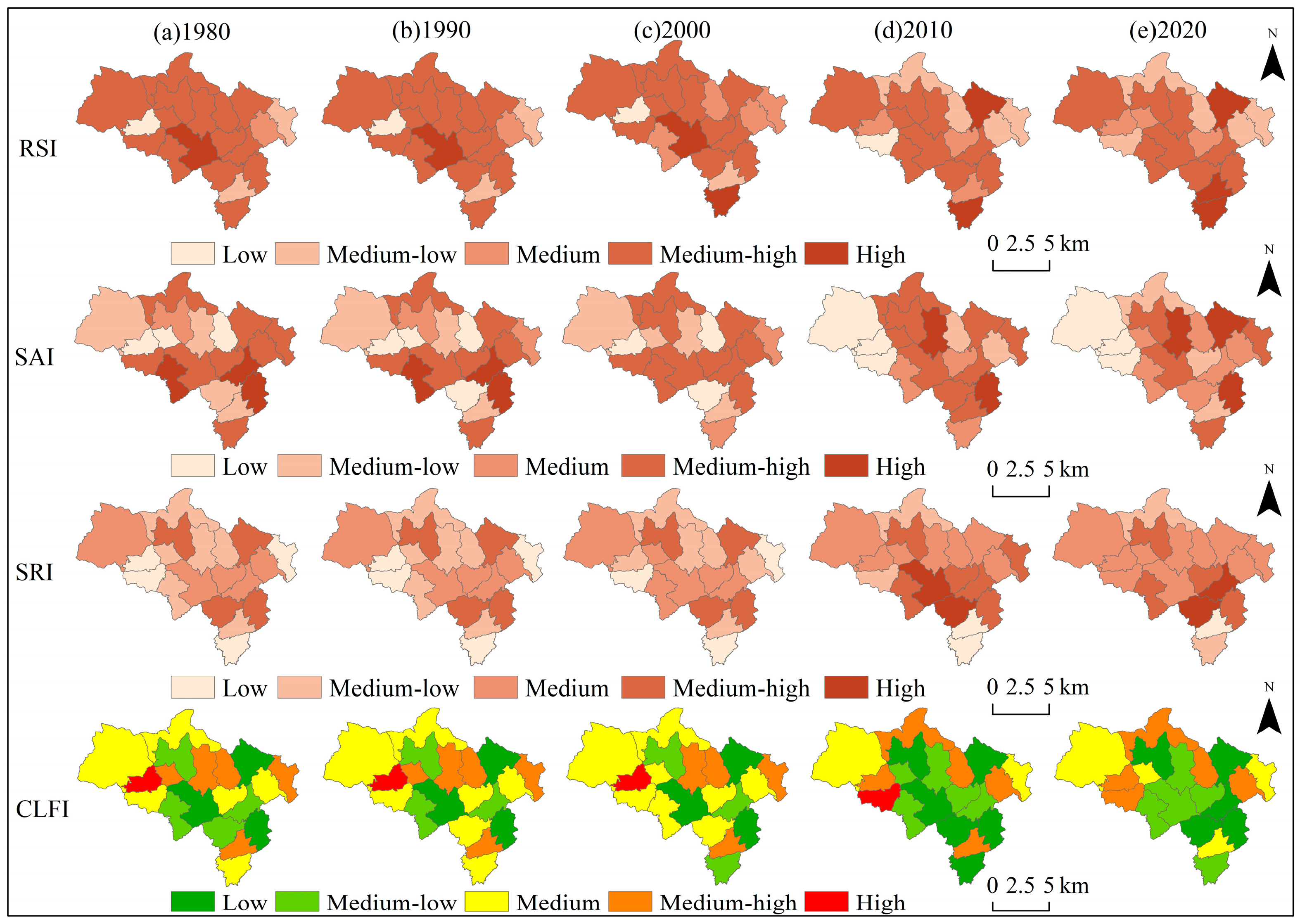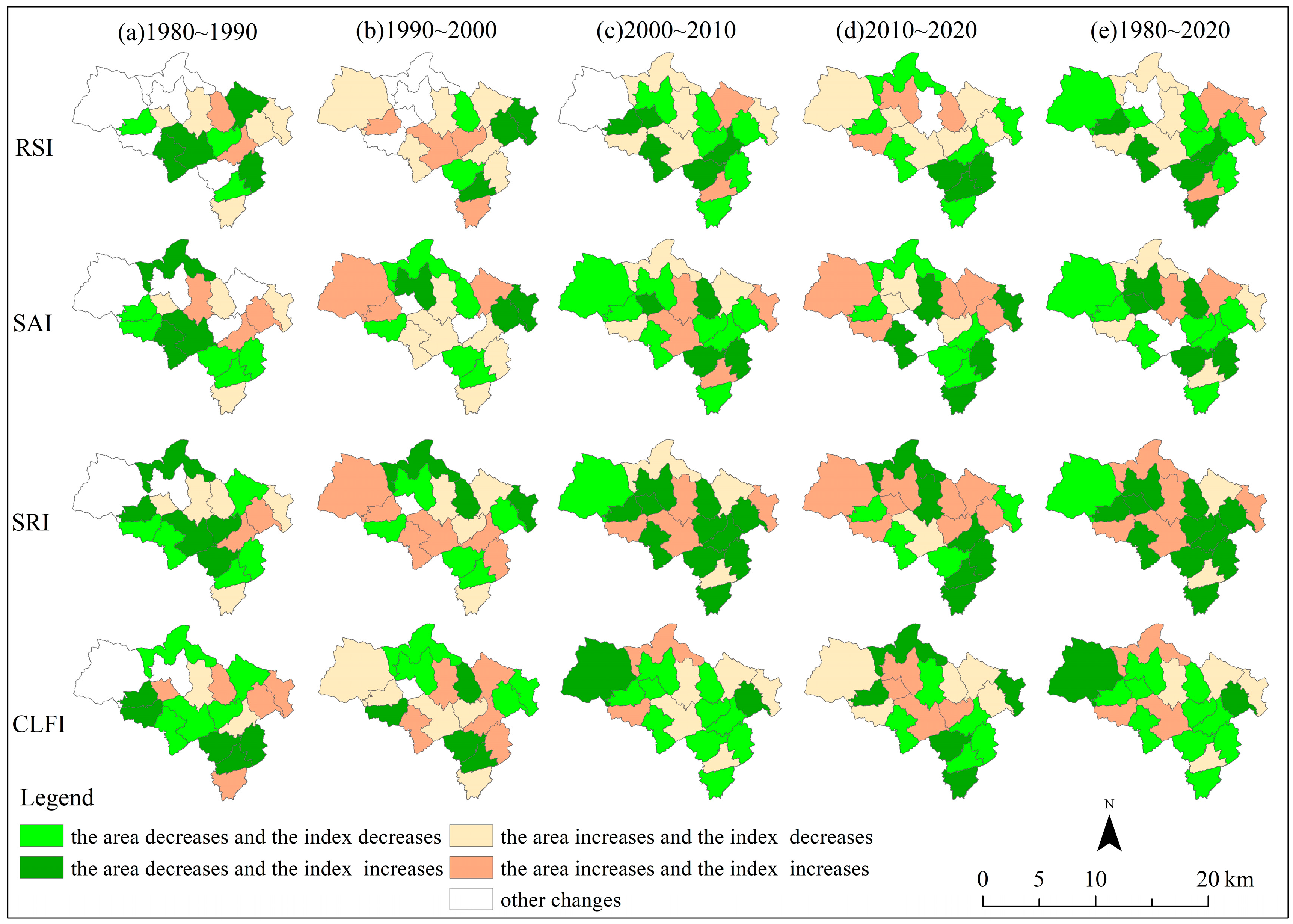Heterogeneous Changes and Evolutionary Characteristics of Cultivated Land Fragmentation in Mountainous Counties and Townships in Southwest China: A Case Study of Beichuan Qiang Autonomous County
Abstract
1. Introduction
2. Materials and Methods
2.1. Study Area
2.2. Land-Cover Data
2.3. Method
2.3.1. Mean Center
2.3.2. Standard Deviation Ellipse
- (1)
- Ellipse center
- (2)
- Orientation angle ()
- (3)
- Standard Deviation Calculation (Ellipse Axis Length)
2.3.3. Measurement of Cultivated Land Fragmentation Index (CLFI)
- (1)
- Indicator fuzzification
- (2)
- Identification of positive and negative indicators
- (3)
- Rule base construction
- (4)
- Calculation of each rule’s strength
- (5)
- Calculation of the fuzzy output for each rule
- (6)
- Aggregation of fuzzy outputs
- (7)
- Defuzzifying
3. Result
3.1. Changes in Cultivated Land Area in Beichuan County
3.1.1. Changes in the Transfer of Cultivated Land in Beichuan County
3.1.2. Shifts in the Gravity Center of Cultivated Land Transfer in Beichuan County
3.2. Spatiotemporal Evolution Characteristics of Cultivated Land Fragmentation
- (1)
- Beichuan County exhibited varying township-level trends in cultivated land fragmentation reduction: 63.16% (1980–1990), 47.37% (1990–2000), 63.16% (2000–2010), and 52.63% (2010–2020). Despite periodic fluctuations in these proportions, a consistent downward trajectory emerged, demonstrating progressive mitigation of landscape fragmentation throughout the study period.
- (2)
- Temporal analysis indicates cultivated land fragmentation primarily exhibited moderate levels during the 1980 (31.58%), 1990 (36.84%), and 2000 (42.11%). The subsequent decades (2010–2020) showed a marked shift toward reduced fragmentation, with lower fragmentation levels dominating at 57.89% and 52.63%, respectively.
- (3)
- The spatial scale, agglomeration, and shape regularity indices collectively demonstrate that cultivated land exhibits small-scale characteristics, dispersed distribution patterns, and irregular geometries, resulting in high fragmentation levels—as typified by Baishi’s landscape configuration—due to the combined effects of spatial scale constraints, weak spatial clustering, and low shape regularity. Furthermore, although scattered distribution patterns and irregular boundaries remain prevalent, expanded spatial dimensions demonstrate fragmentation reduction potential, evidenced in Qingpian and Kaiping townships’ landscapes. In contrast, integrated landscapes combining extensive spatial dimensions, clustered distribution patterns, and geometric regularity collectively reduce fragmentation, as observed in Tongquan, Yuli, and Leigu townships.
- (4)
- Topographic analysis reveals distinct spatial patterns: RSI demonstrates minimal elevation and slope dependence; SAI shows positive correlations with lower elevation and gentler slopes; SRI exhibits strong topographic sensitivity, peaking in low-lying flat areas; and CLFI displays an inverse relationship, with low values clustering in plains and high values predominating in mountainous townships.
3.3. Relationship Between Cultivated Land Area Changes and Landscape Fragmentation
3.4. Spatiotemporal Heterogeneity of Cultivated Land Evolution Across Different Elevations
4. Conclusions and Discussion
4.1. Conclusions
- (1)
- From the 1980 to 2020, Beichuan County witnessed that the area of cultivated land transferred in was greater than that transferred out, the area of cultivated land increased; the cultivated land in the low-altitude and gentler slopes of the townships changed significantly, while the cultivated land in the high-altitude and steeper-slope areas changed less. The balance of cultivated land occupation and compensation shifted from the balance of occupation and compensation in other places to that within the towns. During this period, the area of cultivated land transferred out increased in Beichuan County. The area transferred in peaked around 2010, increasing in the earlier period and decreasing afterward. Both transfers in and out exhibited significant changes between 2000 and 2020.
- (2)
- Land-use transitions predominantly occurred between cultivated land and woodland, with post-2000 periods witnessing marked increases in conversions to grassland and construction land. These transitions exhibited a distinct southeast–northwest spatial orientation, with their distribution centroid demonstrating a pivotal shift around 2010—progressing northwestward during 1980–2010 before reversing southeastward from 2010 to 2020.
- (3)
- Between 1980 and 2020, Beichuan County experienced an overall reduction in cultivated land fragmentation. Low-lying townships maintained relatively intact landscape patterns, contrasting with more fragmented configurations in high-altitude mountainous zones. The fragmentation pattern transitioned from predominantly medium levels during 1980–2000 to predominantly medium low and low levels in the 2010–2020 period.
- (4)
- In areas with lower elevations and gentler slopes, the cultivated land area primarily decreased, accompanied by reduced fragmentation. In contrast, higher-elevation regions experienced both a decrease in cultivated land area and an increase in fragmentation.
4.2. Discussion
- (1)
- In areas with lower elevations and relatively flat terrain, cultivated land patches are larger and more conducive to farming. However, during economic development, some cultivated land has been converted to construction land. To resolve this issue, rigorous enforcement of the cultivated land protection policy should be implemented, while simultaneously advancing high-standard farmland development and upgrading agricultural infrastructure in the area. A comprehensive water conservancy system should be established, including agricultural irrigation water sources, irrigation distribution, and drainage. Field roads should be improved to enhance accessibility and meet the requirements for agricultural machinery passage.
- (2)
- In high-altitude regions, cultivated land exhibits dispersed spatial patterns with severe fragmentation and inadequate supporting facilities, resulting in significantly diminished agricultural productivity. Therefore, restructuring farmland configurations to establish consolidated and fully equipped core agricultural zones becomes imperative.
- (3)
- To mitigate cultivated land loss, systematic and evidence-based land supplementation strategies must be implemented, encompassing expansion of productive farmland, transfer of underutilized woodland/grassland, maximization of new cultivated land potential, and sustainable utilization of reserved land resources.
- (4)
- The northwestern region of Beichuan County is characterized by elevated terrain and pronounced slope gradients. Development initiatives in these areas should be tailored to local conditions to ensure rational utilization while preventing soil erosion, protecting wildlife, establishing robust ecological corridors and networks, and enhancing resilience to natural disasters.
Author Contributions
Funding
Data Availability Statement
Conflicts of Interest
References
- Smith, P.; Martino, D.; Cai, Z.; Gwary, D.; Janzen, H.; Kumar, P.; McCarl, B.; Ogle, S.; O’Mara, F.; Rice, C.; et al. Greenhouse gas mitigation in agriculture. Ser. B Biol. Sci. 2008, 363, 789–813. [Google Scholar] [CrossRef] [PubMed]
- Smith, K.R.; Waring, B.G. Broad-scale patterns of soil Carbon (C) pools and fluxes across semiarid ecosystems are linked to climate and soil texture. Ecosystems 2018, 22, 742–753. [Google Scholar] [CrossRef]
- Lu, L.; Han, X.; Zhu, J.; Lv, L.; Sui, X. Assessing Spatiotemporal Dynamics and Future Projections of Land Use Conflicts in Metropolitan Areas under Climate Change. Appl. Spat. Anal. Policy 2025, 18, 1–35. [Google Scholar] [CrossRef]
- Yan, Y.; Yang, W.; Mo, J.; Rao, Y.; Huang, Y.; Zhang, J. Spatio-temporal evolution of cultivated land carbon storage and Identification of carbon sink areas in the Karst Region of Yunnan, Guangxi and Guizhou. J. Wuhan. Univ.(Nat. Sci. Ed.) 2025, 71, 53–61. [Google Scholar]
- Zhou, B.; Aggarwal, R.; Wu, J.; Lv, L. Urbanization-associated farmland loss:A macro-micro comparative study in China. Land Use Policy 2021, 101, 105228. [Google Scholar] [CrossRef]
- Yuan, C.; Zhang, D.; Liu, L.; Ye, J. Regional characteristics and spatial-temporal distribution of cultivated land change in China during 2009–2018. Trans. Chin. Soc. Agric. Eng. 2021, 37, 267–278. [Google Scholar]
- Zhao, A.; Peng, C.; Xu, S.; Zeng, W.; Ma, X. Impact of farmland conversion grain output under the ecological constraint:based in the Northeast of China. China Popul. Resour. Environ. 2017, 27, 124–131. [Google Scholar]
- Liu, J.; Jin, X.; Xu, W.; Wang, S.; Zhou, Y. Characteristic evolution and trend prediction of cultivated land landscape fragmentation in China from 1990 to 2020. Acta Geogr. Sin. 2023, 78, 2163–2185. [Google Scholar]
- Ge, Y.; Zhao, Y.; Ren, H. The effect of farmland fragmentation on the intensity of farmland in different utilization ways. Adv. Earth Sci. 2020, 35, 180–188. [Google Scholar]
- Li, Y.; Yang, X.; Cheng, C.; Wang, J. Spatial features of occupation and supplement cropland based on topographic factors in China from 2008–2010. Resour. Sci. 2012, 34, 1671–1680. [Google Scholar]
- Yuan, J.; Chen, W.; Zeng, J. Spatio-temporal differentiation of cropland use change and its impact on cropland NPP in China. J. Nat. Resour. 2023, 38, 3135–3149. [Google Scholar] [CrossRef]
- Cao, S.; Jin, X.; Yang, X.; Xiang, X.; Xu, C.; Sui, X.; Liu, M.; Zhou, Y. Multidimensional evaluation of the influence of agricultural land consolidation on the fragmentation of cultivated land:Method and demonstration. J. China Agric. Universtiy 2019, 24, 157–167. [Google Scholar]
- Liu, J.; Jin, X.; Xu, W.; Yang, X.; Cao, S.; Xu, C.; Sui, X.; Liu, M.; Zhou, Y. Evaluation of Cultivated Land Fragmentation and Guidance of Land Consolidation at Provincial Level. Sci. Geogr. Sin. 2019, 39, 817–826. [Google Scholar]
- Chen, W.; Duan, B.; Zeng, J. Spatial differentiation and influencing factors of cultivated landscape fragmentation in China from 1980 to 2020. Trans. Chin. Soc. Agric. Eng. 2024, 40, 221–231. [Google Scholar]
- Liu, J.; Jin, X.; Xu, W.; Zhou, Y. Influence mechanism of cultivated land fragmentation on sustainable intensification and its governance framework. Acta Geogr. Sin. 2022, 77, 2703–2720. [Google Scholar]
- Wei, P.; Yu, D.; Hu, Y.; Hu, H.; Sun, K. Evaluating cultivated land fragmentation and remediation zoning under planning management. Trans. Chin. Soc. Agric. Eng. 2024, 40, 283–293. [Google Scholar]
- Wang, Z.; Lv, Q.; Wu, Y.; Wang, Y. The impact of cultivated land fragmentation on part-time behavior of farmers in China. China Land Sci. 2024, 38, 73–83. [Google Scholar]
- Zheng, L.; Chen, Z. Impacts of land fragmentation on farmers’ farmland abandonment and its governance optimization. Geogr. Res. 2024, 43, 200–213. [Google Scholar]
- Ntihinyurwa, P.D.; de Vries, W.T. Farmland fragmentation concourse: Analysis of scenarios and research gaps. Land Use Policy 2021, 100, 104936. [Google Scholar] [CrossRef]
- Lin, X.; Fu, H. Spatial-temporal evolution and driving forces of cultivated land based on the PLUS Model: A case study of Haikou City, 1980–2020. Sustainability 2022, 14, 14284. [Google Scholar] [CrossRef]
- Wang, X. Changes in cultivated land loss and landscape fragmentation in China from 2000 to 2020. Land 2022, 11, 684. [Google Scholar] [CrossRef]
- Liu, J.; Jin, X.; Xu, W.; Zhou, Y. Evolution of cultivated land fragmentation and its driving mechanism in rural development: A case study of Jiangsu Province. J. Rural. Stud. 2022, 91, 58–72. [Google Scholar] [CrossRef]
- Wang, Z.; Wu, J.; Bai, S.; Wang, H.; Chen, Y. Evaluation of cultivated land fragmentation and land consolidation engineering zoning in the loess hilly and gully region—A case study in Wuqi County. Res. Soil Water Conserv. 2022, 29, 300–307. [Google Scholar]
- He, Y.; Lin, X.; Cai, X.; Du, Z. Spatial pattern evolution of ecological land use before and after the earthquake in Beichuan County. J. China West Norm. Univ. (Nat. Sci.) 2024, 45, 381–387. [Google Scholar]
- Liang, X.; Wang, M.; Liu, K. Impact evaluation of Wenchuan earthquake on land use and land cover change in typical striken areas. Saf. Environ. Eng. 2020, 27, 104–111. [Google Scholar]
- Lv, N.; Guo, Y.; Peng, Q.; Yin, F.; Zhang, J.; Liu, X.; Zeng, M.; Xu, Z. Spatiotemporal evolution characteristics and contributing factors of the carbon effect in cultivated land use in Xinjiang. Arid. Zone Res. 2025, 42, 179–190. [Google Scholar]
- Liu, J.; Ning, J.; Kuang, W.; Xu, X.; Zhang, S.; Yan, C.; Li, R.; Wu, S.; Hu, Y.; Du, G.; et al. Spatio-temporal patterns and characteristics of land-use change in China during 2010–2015. Acta Geogr. Sin. 2018, 73, 789–802. [Google Scholar]
- Zadeh, L.A. Fuzzy logic. In Granular, Fuzzy, and Soft Computing; Springer: Berlin/Heidelberg, Germany, 2009; pp. 19–49. [Google Scholar]
- Wang, M.; Wang, Y.; Liu, A.; Dong, Y.; Mao, J. Risk analysis and heterogeneity of negative population growth in China’s urban agglomerations under the effect of endogenous and exogenous Growth. Trop. Geogr. 2024, 44, 583–595. [Google Scholar]








| Multi-Attributes | Index Name | Index Description |
|---|---|---|
| Resource size index (RSI) | Mean patch size (MPS) | Average area of all cultivated land patches in the landscape |
| Total area (TA) | Sum of the areas of all cultivated land patches in the landscape | |
| Patch density (PD) | Number of cultivated land patches per unit area | |
| Splitting index (SPLIT) | Used to measure the extent to which cultivated land is fragmented into separate patches, with higher values indicating a greater number of patches or more dispersed areas | |
| Spatial agglomeration index (SAI) | Mean proximity index (MPI) | Spatial proximity between cultivated land patches, used to evaluate the clustering or dispersion of patch distribution |
| Mean Euclidean nearest-neighbor distance (MENN) | Used to quantify the average geometric distance between neighbors of cultivated land, reflecting the clustering or dispersion of distribution | |
| Number of patches (NP) | Used to measure the number of cultivated land patches in the region | |
| Landscape division index (LDI) | Used to reflect the extent to which cultivated land is fragmented into patches, with a range of (0,1), where a value closer to 1 indicates a more fragmented landscape | |
| Shape regularity index (SRI) | Mean shape index (MSI) | A measure of the complexity of the shape of cultivated land patches, usually by calculating the ratio of patch perimeter to area, with larger values indicating more complex patch shapes and smaller values indicating more regular shapes |
| Landscape shape index (LSI) | A measure of the complexity of the shape of cultivated land, with larger values indicating more irregular patch shapes and higher boundary complexity, and smaller values indicating more regular shapes |
| Woodland | Grassland | Water | Construction Land | Unused Land | ||
|---|---|---|---|---|---|---|
| Transfer-out | 1980~1990 | 0.11 | 0.00 | 0.00 | 0.08 | 0.00 |
| 1990~2000 | 1.30 | 0.05 | 0.00 | 0.10 | 0.00 | |
| 2000~2010 | 10.13 | 4.40 | 0.26 | 0.43 | 0.59 | |
| 2010~2020 | 14.98 | 0.81 | 0.29 | 1.63 | 0.06 | |
| Transfer-in | 1980~1990 | 0.11 | 0.00 | 0.00 | 0.00 | 0.00 |
| 1990~2000 | 2.04 | 0.02 | 0.01 | 0.00 | 0.00 | |
| 2000~2010 | 15.22 | 1.71 | 0.05 | 0.06 | 0.00 | |
| 2010~2020 | 15.20 | 0.69 | 0.27 | 0.30 | 0.08 |
| RSI | SAI | SRI | CLFI | |
|---|---|---|---|---|
| Low | <0.440 | <0.465 | <0.479 | <0.490 |
| Medium–low | [0.440,0.475) | [0.465,0.480) | [0.479,0.493) | [0.490,0.501) |
| Medium | [0.475,0.494) | [0.480,0.492) | [0.493,0.512) | [0.501,0.514) |
| Medium–high | [0.494,0.520) | [0.492,0.507) | [0.512,0.541) | [0.514,0.531) |
| High | ≥0.520 | ≥0.507 | ≥0.541 | ≥0.531 |
Disclaimer/Publisher’s Note: The statements, opinions and data contained in all publications are solely those of the individual author(s) and contributor(s) and not of MDPI and/or the editor(s). MDPI and/or the editor(s) disclaim responsibility for any injury to people or property resulting from any ideas, methods, instructions or products referred to in the content. |
© 2025 by the authors. Licensee MDPI, Basel, Switzerland. This article is an open access article distributed under the terms and conditions of the Creative Commons Attribution (CC BY) license (https://creativecommons.org/licenses/by/4.0/).
Share and Cite
Liu, M.; Wu, F.; Mo, C.; Xiao, R.; Yu, H.; Wang, M. Heterogeneous Changes and Evolutionary Characteristics of Cultivated Land Fragmentation in Mountainous Counties and Townships in Southwest China: A Case Study of Beichuan Qiang Autonomous County. Land 2025, 14, 1395. https://doi.org/10.3390/land14071395
Liu M, Wu F, Mo C, Xiao R, Yu H, Wang M. Heterogeneous Changes and Evolutionary Characteristics of Cultivated Land Fragmentation in Mountainous Counties and Townships in Southwest China: A Case Study of Beichuan Qiang Autonomous County. Land. 2025; 14(7):1395. https://doi.org/10.3390/land14071395
Chicago/Turabian StyleLiu, Mengqin, Fengqiang Wu, Caijian Mo, Rongjian Xiao, Huailiang Yu, and Meimei Wang. 2025. "Heterogeneous Changes and Evolutionary Characteristics of Cultivated Land Fragmentation in Mountainous Counties and Townships in Southwest China: A Case Study of Beichuan Qiang Autonomous County" Land 14, no. 7: 1395. https://doi.org/10.3390/land14071395
APA StyleLiu, M., Wu, F., Mo, C., Xiao, R., Yu, H., & Wang, M. (2025). Heterogeneous Changes and Evolutionary Characteristics of Cultivated Land Fragmentation in Mountainous Counties and Townships in Southwest China: A Case Study of Beichuan Qiang Autonomous County. Land, 14(7), 1395. https://doi.org/10.3390/land14071395







